No Running Water at Home
For people in industrial societies, few activities demand more privacy than washing and grooming the body. We usually do it alone, in our private bathrooms, with locked doors. Seen in a historical context, that is unusual. Bathing in the presence of others has been the rule rather than the exception. As late as the first half of the twentieth century, many households, even in the most advanced industrial societies, did not have running water at home, let alone a private bathroom. 1
A bathroom requires a domestic water supply, but also a sewer drain, and an energy source to heat the water. Of course, it’s possible to have a hot bath at home without these infrastructures. Ever since Antiquity, the rich have built private baths in their houses. Most often, they could do that because less well-off people – either servants or slaves – filled and emptied their bathtubs with bucketloads of water and collected firewood to heat them.
However, for most people, it was more practical to take their bodies to the water rather than the other way around. For some, that meant bathing in rivers, lakes, and springs. For others, especially in urban environments, it meant visiting the public bathhouse.
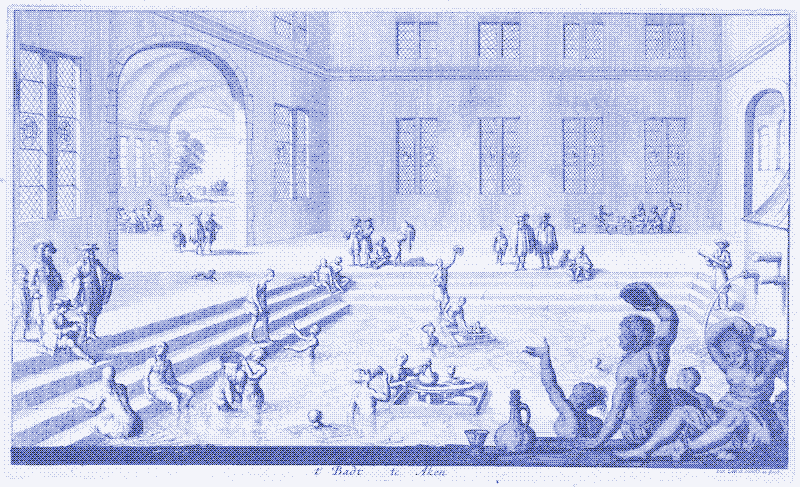
Image: Bathhouse in Aachen Germany, by Jan Luyken, 1682.
Is Bathing Unsustainable?
Modern bathing practices are a textbook example of an unsustainable lifestyle based on fossil fuels. Hot water production is the second largest energy use in many homes (after space heating and/or cooling), and much of it is used for bathing or showering. 2 The modern bathroom also uses a lot of water and adds extra energy use through space heating and waste-water treatment. Building and renovating bathrooms requires resources, too.
Sustainability advocates follow two strategies to address these problems. The first strategy concentrates on technological solutions, such as low-flow showerheads, water boilers heated by solar collectors, waste-water heat recovery systems, and greywater recycling. The second strategy counts on behavioral or social changes by questioning modern standards of cleanliness and comfort: bathing or showering shorter and less frequently, taking cold showers, or doing a cat wash at the sink. 2 3
These strategies are unlikely to bring much results. Many technological fixes are difficult or impossible to install in existing buildings, especially in cities. For example, as the number of floors increases, an apartment building quickly runs out of roof space to install solar collectors for all residents. On the other hand, promoting discomfort as a sacrifice for sustainability is unlikely to engage broader environmental practices. 3 4
Communal bathing could be a third approach, but it’s rarely mentioned. That’s remarkable because, in terms of resource efficiency, it’s hard to beat. Building and operating a bathhouse for 1,000 people requires much less energy than building and operating 1,000 individual bathrooms. A public bathhouse is also more efficient concerning materials, money, and space. 5
Just as importantly, public bathing makes applying the sustainable technologies mentioned above more feasible. That further reduces energy consumption and makes it possible to disconnect bathing practices from fossil fuels. Finally, a public bathhouse can achieve significantly improved sustainability without promoting discomfort. On the contrary, pooling resources to build something for a community rather than for every household separately allows for a high level of sustainable extravagance. That may be an easier sell than cold showers.
Bathing in Rivers, Lakes, and Hot Springs
Nature has provided humans with bathing facilities through streams, rivers, pools, lakes, waterfalls, and rain showers. Humanity spent much time in tropical Africa, where bathing did not require artificially heated water for comfort. When we moved into colder climates, Nature presented us with another solution: hot springs. Many tens of thousands of thermal springs exist around the planet — only a few present-day countries lack them entirely. 6 7
Bathing in hot springs was common in ancient civilizations all over the world. However, it’s a practice that goes back even further in time. Archeological evidence abundantly shows that many prehistoric settlements established themselves near hot springs. 6 8 It’s impossible to prove rock solid that people used those waters for bathing, but why wouldn’t they, especially in cold regions? 9
Today’s bathing culture relies on fossil fuels, but if we consider the historical context, enjoying a hot bath is not unsustainable. In the case of hot springs, the entire infrastructure and operation — water supply, drainage, and heat source — are already in place.
Our ancestors also invented the steam or sweat bath to take advantage of cold water in all seasons and climates. Rather than heating water, it heats people so they can bathe comfortably in cold water. The earliest steam huts, from prehistoric times, were little more than small log cabins or tent-like structures covered with woolen blankets or hides. 10 11 12 13
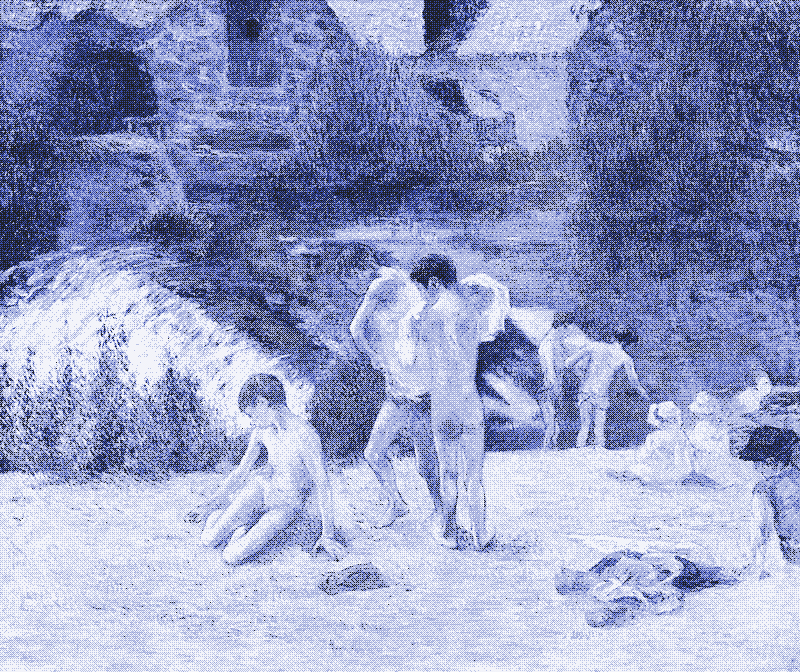
Painting: Bathing Place, oil on canvas, Paul Gauguin, 1886.
The Birth of the Bathhouse
Artificial bathing facilities made from brick or stone appeared around 4,000 years ago. 14 They could be an open-air pool, a bathhouse, or a private bathroom. Many bathhouses and bathing pools were built on top of natural hot springs, modifying the natural environment to make it more convenient, safe, and attractive.6 8 People also began to divert water into urban bathing facilities using canals, pipes, and aqueducts. They started building baths that used artificially heated water as well.
The Ancient Romans are most famously associated with the public bathhouse, although they took much inspiration from the Ancient Greeks. Greek bathhouses comprised rooms with individual hip baths against the walls. Sitting up straight, the bathers threw hot water over themselves or had this done by a servant. In contrast, Roman bathers shared the water in large bathtubs or pools. Both used steam baths as well. 15 16 17 18
At the height of the Empire, there were around 1,000 public baths in the city of Rome alone for a population of about 1 million people – one bathhouse per 1,000 people. 8 19 The most prominent bathhouses were the “thermae,” which could hold up to a few thousand people bathing at the same time. These facilities, which only appeared in the largest cities, were richly decorated with mosaics, marble floors and pools, granite columns, and statues. However, most Ancient Roman bathhouses were smaller neighborhood baths called “balnea.” 15
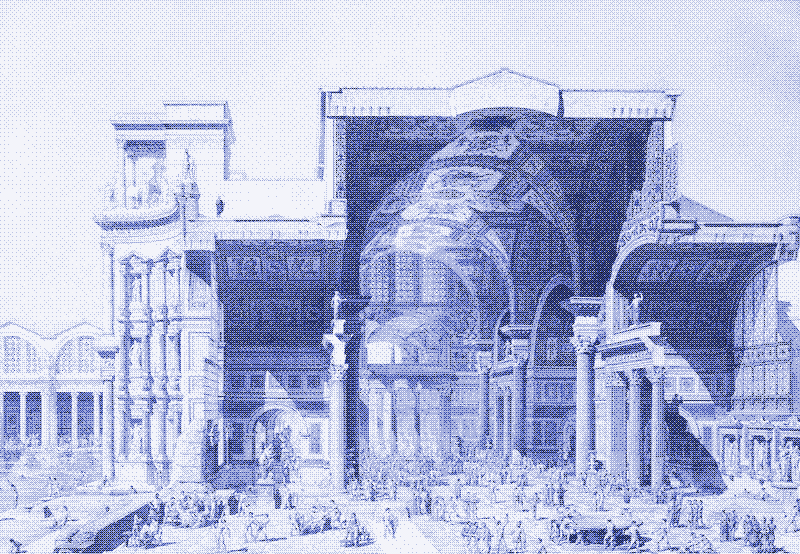
Image: Cross-section of the Baths of Diocletian by French architect Edmond Paulin, 1880. This bath complex was the largest of Ancient Rome, with a capacity of over 3,000 people.
The Preindustrial Bathhouse
The public bathhouse’s history continues after the Roman Empire’s demise. In the East, the Roman bathhouse evolved into the hammam, which ditched the pools and concentrated more on sweating as a cleaning method.20 21 After a sweat bath, people threw water over themselves. Reminiscent of the small Roman baths known as balnea, hammams spread in large numbers in all cities of the Islamic world as they facilitated bodily cleanliness and the accomplishment of body ablutions before praying. 22
In Western Europe, many Roman baths fell into disrepair. However, the public bathhouse returned in full swing during the late Middle Ages, when a new period of urbanization set in. 23 24 25 In the 13th, 14th, and 15th centuries, a lot of European cities had a public bathhouse per 2,000 to 5,000 citizens.26 Many were steam baths inspired by the hammam. A second type of bathhouse offered wooden bathtubs to seat a small group of people. The medieval bathhouse was known as a “stew,” which refers to the oven that either heated water for the bathtubs or filled the room with steam. 23 25
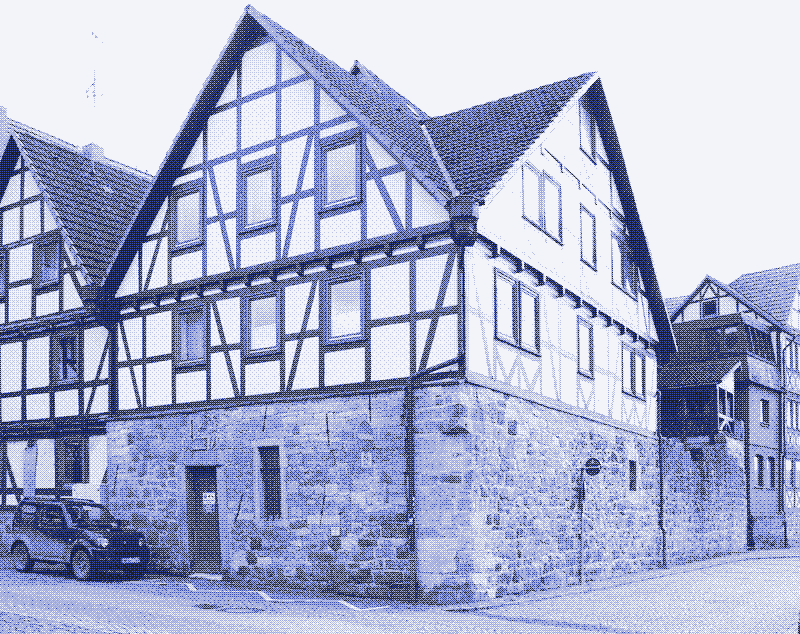
Image: A former medieval bathhouse, built in 1562, in Münden, Germany. Photo by Axel Hindemith (CC BY-SA 4.0).

Image: The women’s bathhouse, by Albrecht Dürer, 1496.
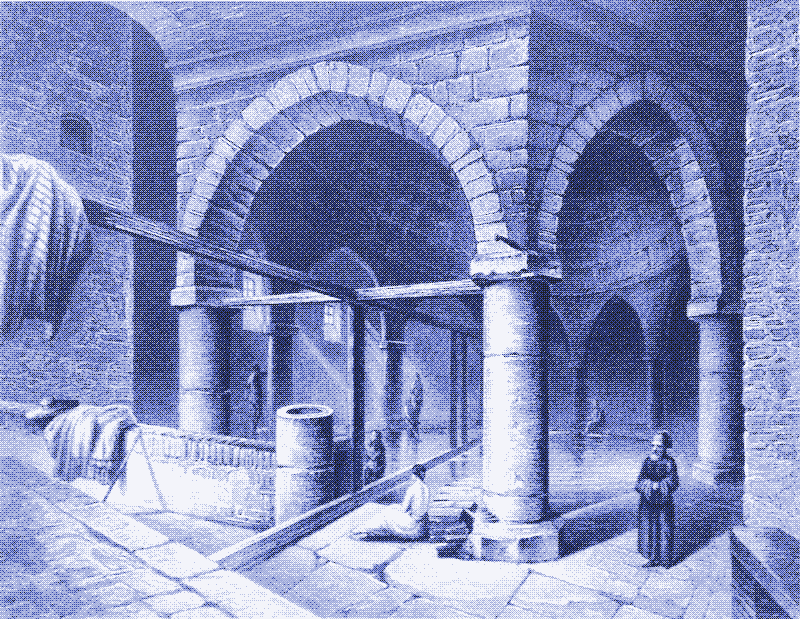
Painting: Rudas Baths, Ludwig Rohbock, 1850. The Rudas Baths in Budapest were built in 1550 and are still in operation.
Northern Europe and Russia – never conquered by Roman or Islamic Empires – stuck to sweat and hot air baths. For example, public “banyas” existed in towns throughout Muscovy during the Middle Ages. 12 Asia also developed independent bathing cultures. For instance, in late medieval Japan, people shared private hot baths among families, neighbors, and friends for economic reasons. For these “cooperative baths” of mostly four to ten individuals, every bather brought a portion of firewood to heat the water. That practice evolved into larger public baths – “sento” – which experienced rapid growth from the fifteenth century onwards.27 28
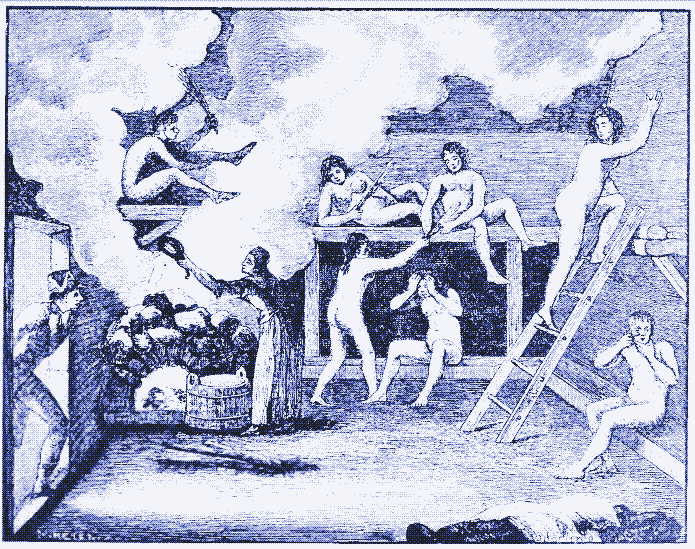
Image: Women taking a vapour bath. Wood engraving by Olaf Sörling.
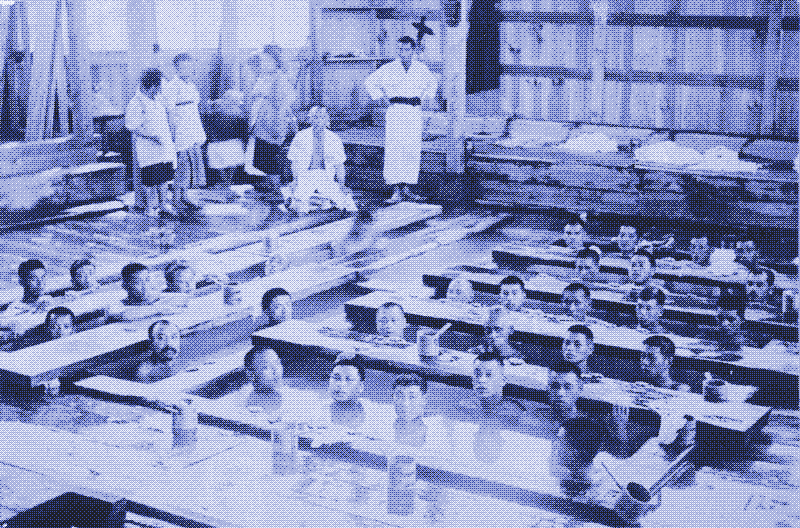
Image: Men in a Japanese bathhouse, early twentieth century. Image in the public domain.
Bathing for Pleasure
Nowadays, sustainability advocates who promote shorter or less frequent showers implicitly regard bathing as a strictly utilitarian practice. However, for most of history, bathing was never just about hygiene. Apart from getting clean, people also visited public baths to relax, have fun, and socialize. Rather than a quick affair, the bathing process — no matter its form — often went on for hours. 15 28
The Ancient Greeks sat together in individual bathtubs, having conversations, for which the space’s acoustics were optimally suited. 29 In Ancient Rome, public baths were places where people went almost daily to be seen, mingle, relax, gossip, dine, or play sports and study. Bathers accessed beauty treatments such as massages, shaving, hairdressing, and depilating. They celebrated parties and anniversaries and honored foreign guests. 15 17 19 25 30
The medieval European bathhouse continued these traditions with less splendor but not necessarily with less revelry. In particular, medieval stews with wooden bathtubs were often a place of amusement that also furnished food, drink, music, and various types of bodily care. 23 In Japan, during the 16th century, public baths became places to gather and socialize, with large groups of people eating, drinking, and singing. 27 28 River bathing, which continued around cities and in rural areas until the 20th century, was a kind of play in which swimming was a potential element. 31
At the same time, bathing was considered essential to prevent and cure diseases, following the Hippocratic ideas that people could maintain or restore the balance of bodily fluids by exposing the body to cold, hot, moist, or dry circumstances. The layout of preindustrial baths reflected these ideas, featuring pools and spaces of different temperatures. 15 21
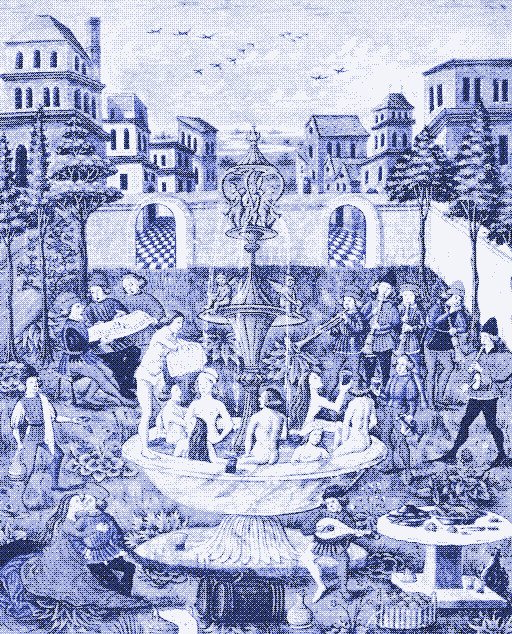
Image: Miniature drawing in “De Sphaera Mundi”, written by Johannes de Sacrobosco, circa 1230.
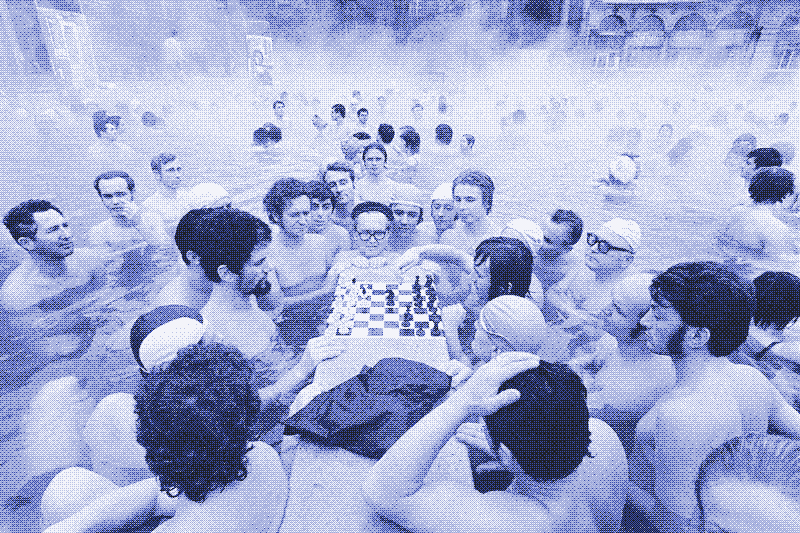
Playing chess at the Széchenyi Baths in Budapest, Hungary, 1970s. Photo by Kereki Sándor. Found at Fortepan. (free to reuse)
Communal Luxury
While these elements of pleasure, social interaction, and health continue today in mineral spas, there is a crucial difference with earlier bathing practices. The present-day spa is far too expensive to substitute for a private bathroom. In contrast, the historical public bathhouse was an egalitarian institution.
Roman public baths had no or low entrance fees and were open to everyone. There were no areas reserved for higher-ranking patrons. Combined with the splendid architecture and opulent decoration of the baths, this ensured that even the most humble servant would have a taste of luxury. 15 17 19 These customs continued into the European Middle Ages and were shared by bathing cultures across the world. 23 For example, in Japan, the bathhouse aided in “slowly deconstructing the existing social hierarchy and created a new cultural flow between the elite and the commoners.” 28 32
The only separation happened between men and women, and it was far from universal across space and time. They would either go to different bathhouses, occupy different sections, or share the same spaces at different times of the day or the week. 12 15 17 19 23
The Fuel Use of Roman Bathhouses
How sustainable was that communal luxury? Most research about the energy use of bathhouses concerns Ancient Roman baths. Historians have sometimes faulted the large bathhouses from the Empire for their wastefulness, arguing that their widespread use caused deforestation. 33 34 35 However, in recent years, archeological research, thermal analysis, and heat transfer studies have made it increasingly clear that Ancient Roman bathhouses, in spite of their opulence, were remarkably energy-efficient buildings. 36 33
The first reason was the hypocaust system. It consisted of one or more underground furnaces that distributed hot air under the floor and into the hollow walls (some baths had heated ceilings, too). Because of the large radiant surfaces, the spaces in the building could be heated at a lower temperature, saving energy. Although the water for the pools was reheated periodically in an insulated boiler close to the furnace, the heat in the floors and the walls helped to keep it warm for an extended period. 36 33
A study of the Stabian Baths, one of the oldest surviving thermae, shows a fuel consumption of between 5 and 8 kg of firewood per hour, depending on the season. 36 37 That corresponds to a wood supply of slightly more than 60 ash trees per year, which was unlikely to cause deforestation. 36 Firewood consumption was probably even lower because Roman baths routinely supplemented wood with other locally available fuels, often waste products: reeds, harvest by-products (olive pits, orchard trimmings, chaff), and animal wastes (dung and bones). 33
Following the same methodology, a study of a later bathing complex – the Forum Baths in Ostia – shows that the Romans continued improving their bathhouses’ energy efficiency. 38 39 The Forum Baths were three times larger than the Stabian Baths – 923m2 versus 310m2 of heated spaces – but their calculated annual wood consumption is not even twice as high: roughly 100 trees per year. 38 36 The newer bathhouse had thicker walls (two meters instead of one meter), as well as much larger glazed windows, which increased the share of solar radiation. 40 Earlier research has shown that the Forum baths were heated almost exclusively by solar energy on sunny days. 41
The studies above assume that the Romans heated their baths for 24 hours daily and only shut them down for maintenance. Roman bathhouses likely continued to be heated through the night, as it was more practical and energy-efficient. Many baths were open daily, and it could take a whole day to heat them from a cold state. In later centuries, medieval stews and hammams often used the heat or the ashes of the furnace to bake bread and other foods at night. 42 Hammams and medieval stews were less energy-efficient than Roman baths. Hammams had heated floors but no heated walls and few windows, while medieval stews often had none of these.
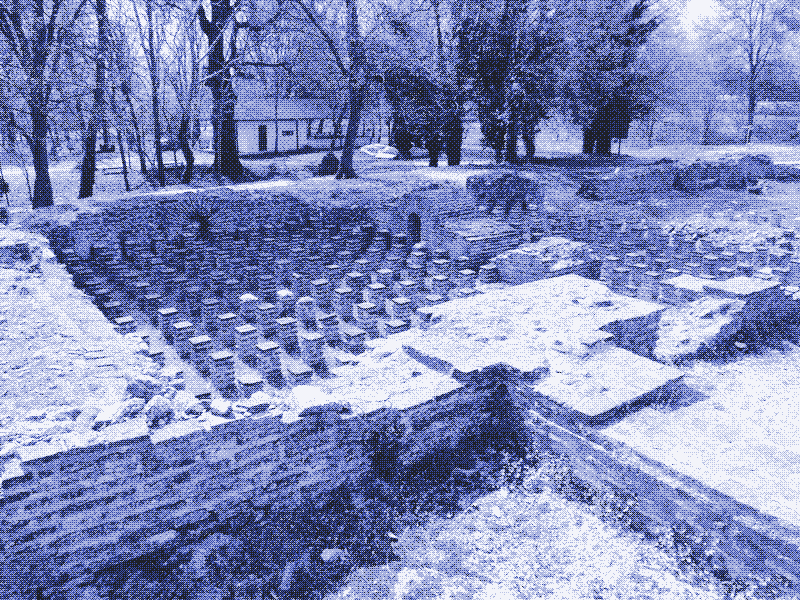
Image: The hypocaust of the Great Baths complex, Ancient Dion. Image by Carole Raddato (CC BY-SA 2.0).

Image: Historical Reconstruction of the Roman Baths in Weißenburg, Germany, using data from laser scan technology. Credit: CyArk. CC BY-SA 3.0
Roman Bathhouse Versus Private Shower
How does the energy use of the Roman bathhouse compare to that of the modern shower? Academic research does not provide an answer, but a quick calculation shows that the Roman bathing experience, which lasted for hours, was more energy-efficient than the present-day private shower, which lasts, on average, 9 minutes. The daily energy use of the Forum baths corresponds to the daily energy use of 557 showers. 43 While we don’t know how many people visited the Forum Baths daily, they likely surpassed that number: the baths could host up to 500 bathers simultaneously. 44
Furthermore, in the calculation above, the energy use for the shower only concerns water heating, while the fuel use for the public baths also – and mainly – includes space heating. 36 For example, assuming that the water in the pools of the Stabian baths was changed only once per day, heating the water accounted for less than 10% of the total energy use, corresponding to the energy use of only 52 showers. The low energy use for water heating is partly explained by the excellent thermal insulation of the heated floors and walls, meaning that space and water heating cannot be separated. However, it is also because the Romans shared the water in pools, while every shower requires freshly heated water.
The Roman bathhouse also compares favorably to the typical backyard sauna, for which the fuel consumption hovers between 5 and 15kg of firewood per session. 45 Only sixteen such sauna sessions require as much fuel as the Stabian baths used daily. The sauna has no heated floor and walls. Furthermore, historically, it was often built partly underground to save fuel, but nowadays, it’s usually a badly insulated building standing in a cold climate.

Image: Bathing sandals for women, Saudi Arabia. Heated floors of hammams were too hot to walk on barefoot. Source: Wereldmuseum (CC BY-SA 4.0).
The Public Baths of the Industrial Revolution
Bathing practices have changed quite a lot since Roman and late medieval times, particularly in most of the Western world. Few of us will have the time or even the need to linger in a bathhouse for several hours daily, and some of us may feel uncomfortable bathing in public. 30 However, a bathhouse can also take a form more in line with modern bathing habits. The public bathhouse of the Industrial Revolution demonstrates this.
In the nineteenth and early twentieth centuries, cities received large numbers of immigrants who came to work in factories. Most of these people were housed in overcrowded tenement buildings without running water, leading to unsanitary conditions. 46 Recurring epidemics and new medical insights led to a “gospel of cleanliness” that resulted in a new wave of public bathhouses across the Western world. Many of these baths only disappeared between the 1950s and 1980s.
The public hygiene movement began in England and peaked there in the 1840s. By 1896, more than 200 municipalities in Britain were maintaining public baths. The English bathhouse emulated the splendor of Roman baths in its architecture and decoration: it was “large, handsome, and costly.” 46 However, it did not copy the Ancient bathing customs. It now reserved different sections of the bathhouse for different social classes. Furthermore, while the pools still provided social interaction, the bathtubs were now placed in individual compartments. Finally, the modern bathhouse instituted maximum time limits for using the pool and the bathtubs. 46 47 48

Image: Nechelles public baths in Birmingham, England, 1910. Image by Oosoom (CC BY-SA 3.0).
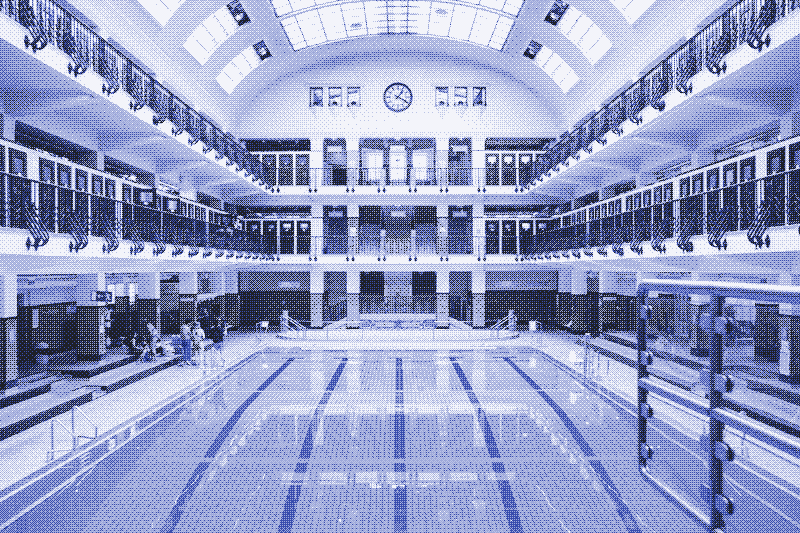
Image: The restored interior of the Amalienbad in Vienna, Austria, built in 1926. It was one of the largest bathhouses in Europe at the time, holding up to 1,300 bathers simultaneously. The original roof could slide open in good weather. Image by Schwimmschule Steiner (CC BY-SA 4.0).
The Shower Bathhouse
Germany, the first to follow the British on the continent, also built monumental bathhouses. 49 However, in the 1880s, Berlin physician Oscar Lasser argued that the large baths were too costly to build in the necessary numbers. He proposed the introduction of smaller bathhouses with nothing but showers in individual compartments. Until then, the shower was only attached to a bathtub or used in barracks and prisons, where soldiers and inmates were showered with cold water. 48 46 25
The shower bathhouse became the dominant public bath type in most of Western Europe and also in North America, where the sanitary reform movement took off in the 1890s. 50 51 It cleared away the last vestiges of the Ancient bathing culture by ditching the pools and switching to a more practical architecture. For better or worse, the public bathhouse from the Industrial Revolution was the “antithesis of the preindustrial bathhouse.” 47 Although bathers still made use of communal infrastructure, there was no more space for pleasure, social interaction, public nakedness, and social mixing.
As the higher social classes gradually gained access to their private water supply and bathrooms, the public bath became increasingly associated with poverty. Although shower bathhouses did not have separate sections for different social classes, they were mainly built in low-income neighborhoods, aimed at the poor only. Bathers were led to their shower cubicle by an attendant, who opened the tap, decided on the water temperature, and started a timer. People had at most 20 minutes to undress, shower, and dress again.46 47 “The poor had to be clean but not enjoy it too much.” 46
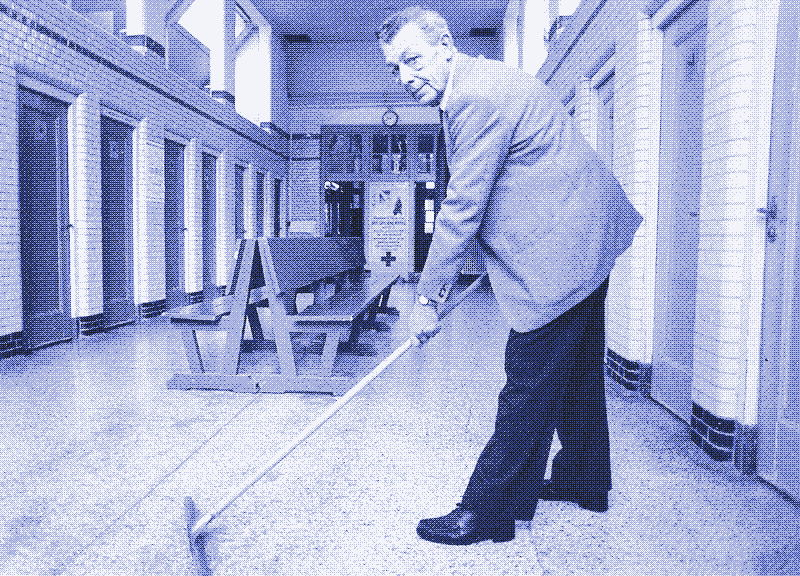
Image: The last bath attendant of a bathhouse in Haarlem, the Netherlands, in 1984. Image in the public domain.
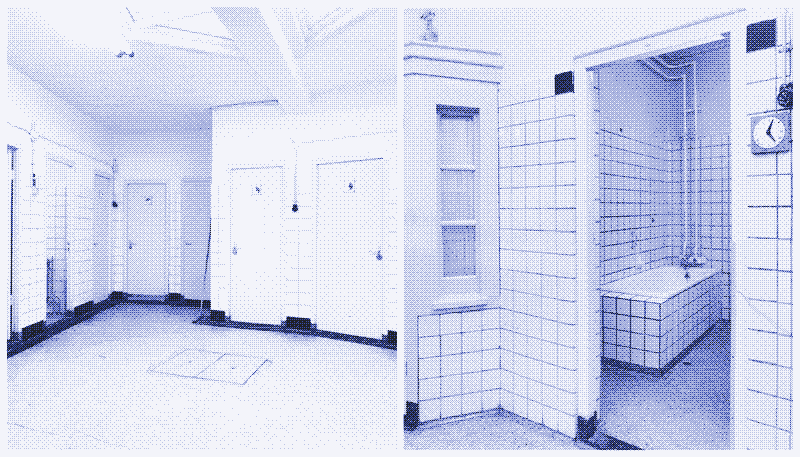
Bath and shower rooms equipped with timers in Amsterdam bathhouses, 1985. Source: Stadsarchief Amsterdam.
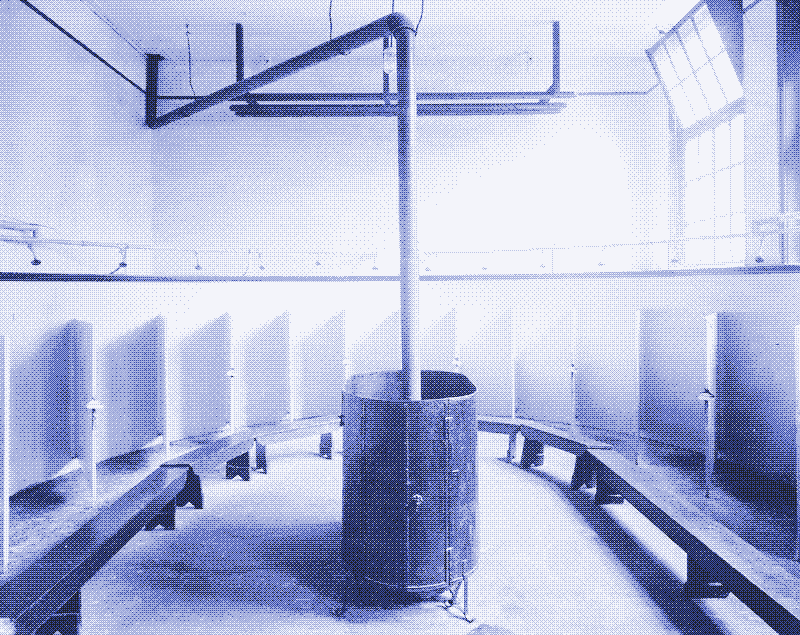
Image: Shower cubicles in a municipal bathhouse in Amsterdam, the Netherlands. Stadsarchief Amsterdam.
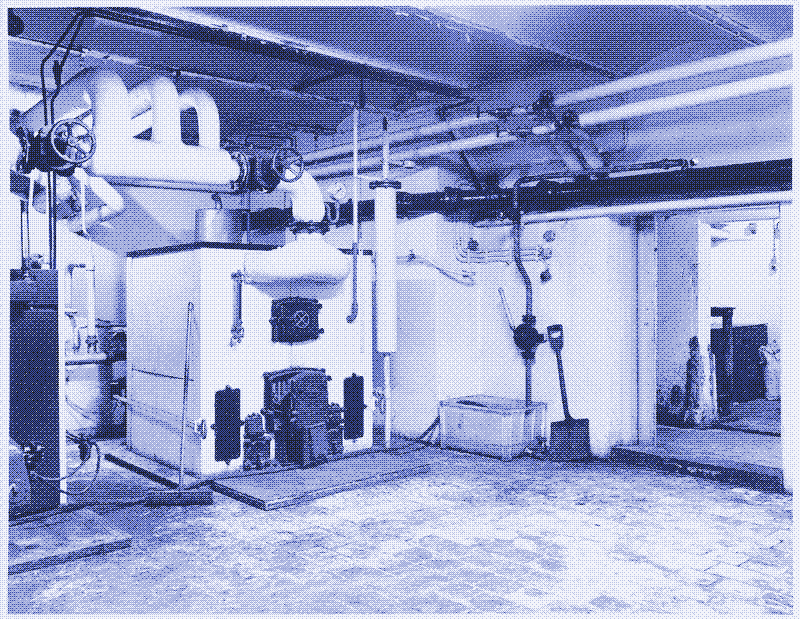
Image: Boiler room of a municipal bathhouse in Amsterdam, the Netherlands, 1985. Stadsarchief Amsterdam.
Bring Back the Public Bathhouse?
In Europe and North America, the public bathhouse disappeared once everyone got their private bathroom – although we still bathe together in sports centers and continue using communal bathrooms in hostels or campings. The public bathhouse survives elsewhere but is in decline almost everywhere. For example, Cairo had only eight hammams in 2000, compared to more than seventy at the beginning of the 19th century.52 53 In 1968, greater Tokyo boasted 2,687 public bathhouses. In 2022, only 462 were left. 54 55
Historically, the bathhouse was born out of the need for efficiency: bathing was too resource-intensive to organize individually. That is no longer the case thanks to the advance of central infrastructures – fossil fuels, electricity, water supply, sewers. However, in the context of the present environmental crisis, the resource efficiency of the public bathhouse has become relevant once again. It’s a solution that could reduce energy use relatively quickly without the need for new technologies or sacrificing comfort. Resilience is another argument for the bathhouse. 56
>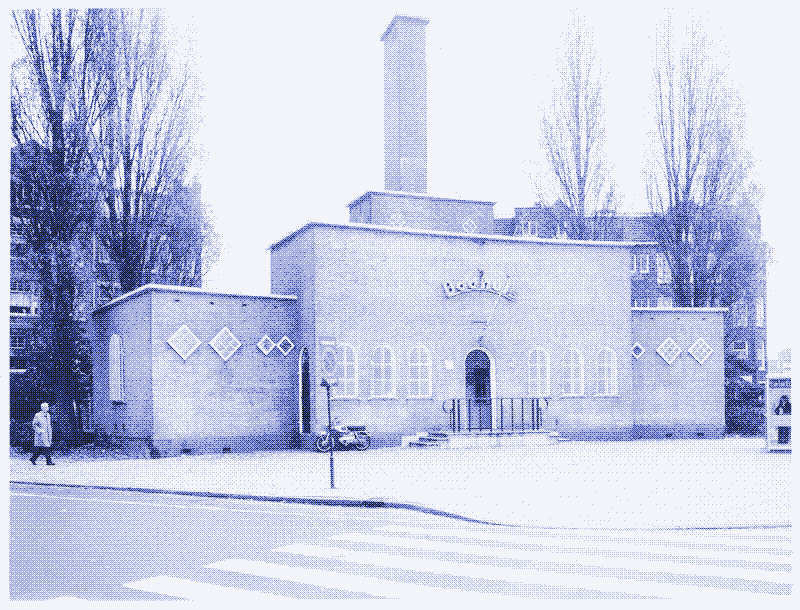
Image: Municipal bathhouse at Javaplein in Amsterdam, the Netherlands. Image: Stadsarchief Amsterdam.
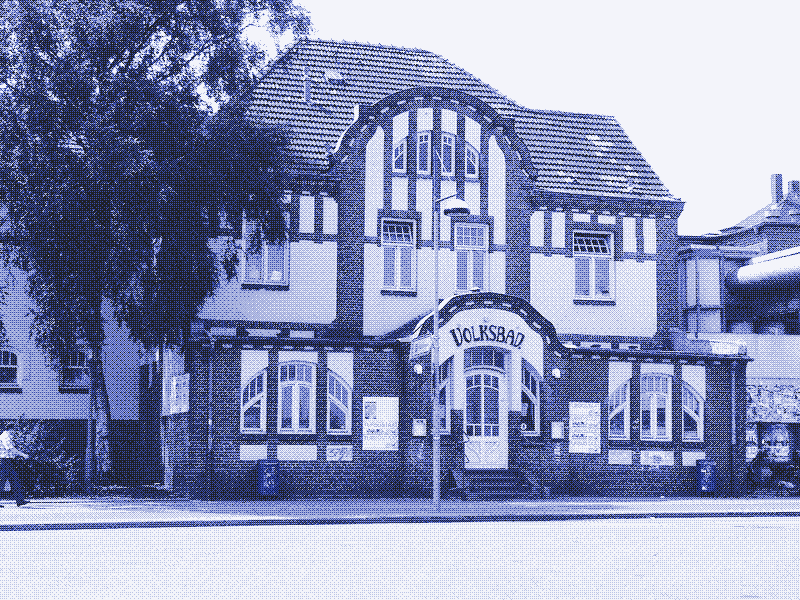
Image: A former bathhouse in Flensburg, Germany. Image: VollwertBIT (CC BY-SA 2.5).
What Type of Public Bathhouse Do We Want?
The metamorphosis of the public bath in the 19th and 20th centuries, which also affected public baths outside the Western world, presents a challenge to anyone wanting to revive public bathing for sustainability. What type of bathhouse do we want? Of course, the Roman bath and the shower bathhouse are both extremes, and many intermediate forms are imaginable. Nevertheless, any designer of a future bathhouse will have to make decisions that are likely to be controversial.
For example, one could argue that the shower bathhouse not only fits modern bathing practices but also maximizes resource efficiency. That is especially true when the government, rather than the bather, controls shower duration and water temperature. In that way, the public bathhouse could become a technology to enforce frugality upon the whole population. However, to put it mildly, such an approach is unlikely to generate enthusiasm for reviving public bathhouses. Neither does it do much to improve social interaction. 57
Advocating for the return of the preindustrial public bathhouse, which centers around social interaction and communal luxury, may be more successful in luring people away from their private bathrooms, but it also runs into obstacles. The public bathhouse has faced resistance for 2,000 years, mostly because of conflicting views about health and morals. 58 For example, concerns about debauchery and prostitution – real and imagined – run throughout the history of the bathhouse in all cultures. 59 Separating males and females does not fully address those worries.

Image: Scene of a bathhouse, c. 1470, painted by the Master of Anthony of Burgundy (Berlin Staatsbibliothek, Ms. Dep. Breslau 2, vol. 2, fol. 244).
Any plea for reviving public baths will also have to deal with the fear of contagious disease. For example, a “lockdown” of society, as many governments applied during the coronavirus pandemic in 2020 and 2021, is incompatible with public bathhouses. Such a measure only works when everybody has a private bathroom. 60 The link between communal bathing and health is complex. Science has confirmed many of the health benefits of cold, hot, and steam baths and has also shown the importance of social interaction. However, bringing people together will always raise health risks, too.
How to Build a Low-tech Bathhouse?
There’s another distinction between bathhouses built before and after the Industrial Revolution: preindustrial baths worked with renewable fuels, while industrial baths ran on fossil fuels. Many modern bathhouses had an on-site coal power plant, which heated the space and the water and provided electricity for lighting. Fossil fuel-powered bathhouses are more energy efficient than fossil fuel-powered private bathrooms, but we can do better than that.
A large bathhouse heated by a hypocaust system and large windows is still hard to beat as a carbon neutral technology, at least based on sustainable wood production. 61 62 However, biomass combustion creates air pollution, while we could also power a bathhouse with renewable energy sources that don’t have that problem. The most apparent solution for space and water heating is flat plate solar collectors in which the sun heats water. Heat-generating windmills are a low-tech alternative to solar thermal collectors in less sunny climates. 63 Other potential heat sources are geothermal energy and factory waste heat.
A solar or wind-powered bathhouse’s biggest drawback is its dependency on favorable weather conditions. To compensate for that, solar or wind power can be combined with thermal energy storage, such as insulated water tanks. Storing heat in a thermal mass for longer periods is much cheaper and more sustainable than storing electricity in chemical batteries. However, it requires space that only communal bathing can offer. Steam baths and saunas are more difficult to disconnect from biomass combustion, but some innovative examples exist. 64
Clustering bathing facilities in a shared infrastructure also creates sufficient space for a bathhouse to have extensive heat insulation (a decisive factor in energy consumption) and provide for its water supply (for example, by catching and storing rainwater) as well as wastewater treatment (for example through phytoremediation using plants).
Architects have applied some of these ideas in countries where public baths are still used. For example, in a mountain village in China, a community bathhouse for 5,000 people is largely off-the-grid, pumping up its water from a well, heating it with solar collectors, and filtering the run-off wastewater from the showers and the toilets in basins filled with bamboo plants. 65
However, a public bathhouse also fits the more high-tech vision of a centralized energy infrastructure based on solar PV panels and wind turbines that provide electricity. In such a configuration, public bathhouses could absorb excess electricity during abundantly sunny or windy days. Rather than curtailing the electricity from surplus solar and wind power, we could use it to power electric heat pumps and store the heat in the thermal mass of public baths. 66 While this approach is less resource-efficient than off-grid bathhouses operating without electricity, it still beats a scenario in which a centralized renewable power grid supplies energy to many private bathrooms.
Kris De Decker
Many thanks to Jonas Görgen and Elizabeth Shove for their feedback on an earlier version of this article.
Marie Verdeil and Roel Roscam Abbing contributed to the selection of images.
- The spread of water supply and sewer networks took a lot of time, especially in older European cities. Before 1900, only the most expensive Paris flats had a bathroom. 26 Plumbed-in private baths appeared in the wealthiest British households in the 1860s. Still, it was not until the 1950s that working-class homes were routinely supplied with hot and cold running water. 3 In the newer cities of the USA, installing a water supply and sewer infrastructure was easier. From the 1870s, American plumbing outstripped that of every other country. More than half of all American houses had a complete bathroom in 1940. For comparison, in the whole of France, only one house or apartment in ten had a shower or bath in 1954. 20 ↩︎
- Mist Showers: Sustainable Decadence?, Kris De Decker, Low-tech Magazine, 2019. https://solar.lowtechmagazine.com/2019/10/mist-showers-sustainable-decadence/ ↩︎ ↩︎ ↩︎ ↩︎
- Pickerill, Jenny. “Cold comfort? Reconceiving the practices of bathing in British self-build eco-homes.” Annals of the Association of American Geographers 105.5 (2015): 1061-1077. https://www.tandfonline.com/doi/full/10.1080/00045608.2015.1060880 ↩︎ ↩︎ ↩︎
- The trend is towards more and longer showers 2 and more, larger and more luxurious private bathrooms. For example, more than one-third of new single-family homes in the US had three or more bathrooms in 2021, compared to “only” a quarter in 2005. Source: Number of Bathrooms in New Homes in 2021, Jesse Wade, National Association Of Home Builders, November 2022. https://eyeonhousing.org/2022/11/number-of-bathrooms-in-new-homes-in-2021/ ↩︎
- How much water public bathing can save depends on how exactly people bathe together. Shared pools and bathtubs bring water savings, but individual showers and bathtubs do not, even if placed in a communal space. ↩︎
- Erfurt, Patricia. “Hot springs throughout history. The Geoheritage of hot springs.” Cham: Springer International Publishing, 2021. 119-182. ↩︎ ↩︎ ↩︎
- Tamburello, Giancarlo, et al. “Global thermal spring distribution and relationship to endogenous and exogenous factors.” Nature Communications 13.1 (2022): 6378. ↩︎
- Cataldi, Raffaele, Susan F. Hodgson, and John W. Lund. Stories from a heated earth: our geothermal heritage. No. 19. Nicholson, 1999. ↩︎ ↩︎ ↩︎
- Even some animals – like snow monkeys and capybaras – are known to enjoy bathing in hot springs. See, for example: Matsuzawa, Tetsuro. “Hot-spring bathing of wild monkeys in Shiga-Heights: origin and propagation of a cultural behavior.” Primates 59.3 (2018): 209-213. https://link.springer.com/content/pdf/10.1007/s10329-018-0661-z.pdf. ↩︎
- Sonntag, C. F. “The History of Baths and Bathing in Britain before the Norman Conquest.” Proceedings of the Royal Society of Medicine 13.sect_hist_med (1920): 25-46. ↩︎ ↩︎
- Aaland, Mikkel. “Sweat: The illustrated history and description of the Finnish sauna, Russian bania, Islamic hammam, Japanese mushi-buro, Mexican temescal and American Indian & Eskimo sweat lodge.” (1978). ↩︎
- Pollock, Ethan. Without the banya we would perish: a history of the Russian bathhouse. Oxford University Press, USA, 2019. ↩︎ ↩︎ ↩︎
- The first written reference to the steam bath dates back to the fifth century BC, when Greek historian Herodotus compared the Scythian sweat bath north of the Black sea to the Greek steam bath of his time. However, it’s very likely that its origins go back to prehistoric times. Not surprisingly, the steam bath and the hot air bath initially spread in regions with cold and long winters: northwestern Europe, Russia, Alaska, and Canada. It was also used by Native Americans, and spread to Central and South America as well. 10 ↩︎
- One of the earliest archeological records of human-made bathing facilities dates back to around 2300 BC in what is now Pakistan. The inhabitants of Mohenjo-daro, the probable capital of the Indus civilization, built wells and drainage systems allowing for private bathrooms in most residential buildings, as well as a large, communal bathing pool. The private bathrooms had a 1m2 shallow platform, where people threw buckets of water over themselves. The “Great Bath” was a brick basin with steps on either side and a capacity for 160 m3 of water. As the city was located in a hot desert climate, there was no need for heating the water. Sources: Graeber, David, and David Wengrow. The dawn of everything: A new history of humanity. Penguin UK, 2021 + Jansen, Michael. “Mohenjo-Daro, Indus Valley civilization: water supply and water use in one of the largest Bronze Age cities of the third millennium BC.” Geo: A new world of knowledge (2011). https://openarchive.icomos.org/id/eprint/1541/1/110601geo_06_2011_indian_edition_email.pdf ↩︎
- Maréchal, Sadi. Public baths and bathing habits in Late Antiquity: a study of the archaeological and historical evidence from Roman Italy, North Africa and Palestine between AD 285 and AD 700. Diss. Ghent University, 2016. https://biblio.ugent.be/publication/7235534/file/7235545.pdf ↩︎ ↩︎ ↩︎ ↩︎ ↩︎ ↩︎ ↩︎ ↩︎ ↩︎ ↩︎
- Fagan, Garrett G. “The genesis of the Roman public bath: recent approaches and future directions.” American Journal of Archaeology 105.3 (2001): 403-426. ↩︎
- Kosso, Cynthia, and Anne Scott, eds. The nature and function of water, baths, bathing, and hygiene from antiquity through the Renaissance. Vol. 11. Brill, 2009. ↩︎ ↩︎ ↩︎ ↩︎
- Both the Greeks and the Romans also used cold baths in combination with sports facilities. Here, the act of washing was secondary. 15 19 ↩︎
- Hoagland, Alison K. The bathroom: a social history of cleanliness and the body. Bloomsbury Publishing USA, 2018. ↩︎ ↩︎ ↩︎ ↩︎ ↩︎
- Ashenburg, Katherine. The dirt on clean: An unsanitized history. Vintage Canada, 2010. ↩︎ ↩︎ ↩︎
- Fournier, Caroline. Les bains d’al-Andalus: VIIIe-XVe siècle. Presses universitaires de Rennes, 2018. https://books.openedition.org/pur/44617#anchor-resume ↩︎ ↩︎ ↩︎
- Sibley, Magda, Camilla Pezzica, and Chris Tweed. “Eco-hammam: the complexity of accelerating the ecological transition of a key social heritage sector in Morocco.” Sustainability 13.17 (2021): 9935 ↩︎
- Coomans, Janna. “Janna Coomans – The Medieval Bathhouse (MA Thesis – 2013).” The Medieval Bathhouse: Bathing Culture in the Late Medieval Low Countries (2013): n. pag. Print. ↩︎ ↩︎ ↩︎ ↩︎ ↩︎ ↩︎ ↩︎ ↩︎ ↩︎ ↩︎ ↩︎ ↩︎
- Wurtzel, Ellen. “Passionate Encounters, Public Healing: Medieval Urban Bathhouses in Northern France.” French Historical Studies 46.3 (2023): 331-360. https://read.dukeupress.edu/french-historical-studies/article/46/3/331/381254/Passionate-Encounters-Public-HealingMedieval-Urban ↩︎ ↩︎
- Büchner, Robert. Im städtischen Bad vor 500 Jahren: Badhaus, bader und Badegäste im alten Tirol. Böhlau, 2014. ↩︎ ↩︎ ↩︎ ↩︎ ↩︎
- Thirteenth century Paris, with 200,000 inhabitants, counted around 30 public bathhouses 23 24, while 14th century London, with a population of 80,000, had at least 18 public baths. 20 In the late 14th century Low Countries, Bruges (30,000 inhabitants) and Ghent (40,000 inhabitants) each had around twenty public baths, while smaller cities like Maastricht and Leuven (15,000 inhabitants) had around five. Vienna (Austria) counted 29 bathhouses in the fifteenth century. 23 Medieval bathhouses, like hammams, were smaller than Roman baths. Medieval stews found in Germany and the Low Countries had a ground surface of between 100 and 200 square meters. 23 The typical roman city bath had a surface of about 500 m2. 15 ↩︎ ↩︎
- Butler, Lee. “Washing Off the Dust”: Baths and Bathing in Late Medieval Japan.” Monumenta Nipponica 60.1 (2005): 1-41. https://web.archive.org/web/20190818120651id_/http://muse.jhu.edu:80/article/182356/pdf ↩︎ ↩︎
- Merry, Adam M., “More Than a Bath: An Examination of Japanese Bathing Culture” (2013). CMC Senior Theses. Paper 665. http://scholarship.claremont.edu/cmc_theses/665 ↩︎ ↩︎ ↩︎ ↩︎ ↩︎
- Gill, A. A. ““Chattering” in the Baths: The Urban Greek Bathing Establishment and Social Discourse in Classical Antiquity.” (2011). https://tobias-lib.ub.uni-tuebingen.de/xmlui/bitstream/handle/10900/61481/CD27_Gill_CAA2008.pdf?sequence=2&isAllowed=y ↩︎
- Górnicka, Barbara. Nakedness, shame, and embarrassment: A long-term sociological perspective. Vol. 12. Springer, 2016. ↩︎ ↩︎
- A Cultural History of Parson’s Pleasure, George Townsend, PhD, Birkbeck, University of London, 2022, unpublished. See also: Dive in! A history of river swimming in Oxford. Museum of Oxford, expo 2023. https://moxdigiexhibits.omeka.net/exhibits/show/dive-in#:~:text=Dive%20In!-,A%20history%20of%20river%20swimming%20in%20Oxford,places%20for%20bathing%20and%20swimming. ↩︎
- The egalitarian nature of the public bath was reinforced by the fact that people were partly or completely naked. “One stripped not only of their clothes but also of their social rank and material wealth, which become largely invisible”, concludes a historian of the Japanese public bath. 28 “The true collective is a naked collective”, observes another, referring to the Russian banya. Source: Gearsimova, A. “My Banya, Your Banya: From Reality to Myth.” (2016). ↩︎
- Mietz, Michael. “The fuel economy of public bathhouses in the Roman Empire.” Master’s thesis, Ghent University, Faculty of Arts and Philosophy, Campus Boekentoren, Blandijnberg 2 (2016): 9000. https://libstore.ugent.be/fulltxt/RUG01/002/303/996/RUG01-002303996_2016_0001_AC.pdf ↩︎ ↩︎ ↩︎ ↩︎
- Wilson, A (2012) Raw materials and energy, in “The cambridge companion to the roman economy, scheidel 2012. ↩︎
- Ancient deforestation revisited, Journal of the history of biology, 44 (1), 43-57. https://www.researchgate.net/profile/J-Donald-Hughes/publication/45407393_Ancient_Deforestation_Revisited/links/08ce17d911d2244431641d70/Ancient-Deforestation-Revisited.pdf ↩︎
- Miliaresis, Ismini. “Heating the Stabian Baths at Pompeii.” Curious (2021): 83. https://library.oapen.org/bitstream/handle/20.500.12657/58973/1/external_content.pdf#page=91 ↩︎ ↩︎ ↩︎ ↩︎ ↩︎ ↩︎
- The study assumes that the baths were heated for 24 hours per day and only shut down for maintenance. The fuel used for heating up the bath initially (calculated at 35 kg in the case of the Stabian Baths) is added only once to the total yearly energy use. The results are also based on the assumption that the water of the baths was changed once per day (and thus had to be heated from a cold state once per day). ↩︎
- Veal, Robyn, and Victoria Leitch. Fuel and Fire in the Ancient Roman World: Towards an integrated economic understanding. McDonald Institute for Archaeological Research, 2019. https://www.repository.cam.ac.uk/bitstreams/c349fc20-11d0-4ad4-a2e9-55dccca9f2df/download ↩︎ ↩︎
- Miliaresis, Ismini Alexandra. Heating and Fuel Consumption in the Terme del Foro at Ostia. Diss. University of Virginia, 2013. https://libraetd.lib.virginia.edu/public_view/5d86p0445 ↩︎
- Whether or not the (small) windows in the Stabian baths had glass or shutters is not entirely clear. The study concludes that energy use is pretty similar with both glazed and unglazed windows. However, the Forum baths, with windows several meters high, would have required almost 1.5 times more wood to heat rooms with unglazed windows during the month of May, and more than twice as much in the coldest month. ↩︎
- Ring, James W. “Windows, baths, and solar energy in the Roman empire.” American Journal of Archaeology 100.4 (1996): 717-724. ↩︎
- This may have been true for Roman bathhouses as well, but I could not find any reference to it. For hammams, see, for example: Sibley, Magda, and Martin Sibley. “Hybrid transitions: combining biomass and solar energy for water heating in public bathhouses.” Energy Procedia 83 (2015): 525-532. ↩︎ ↩︎
- A fuel use of 7.5 to 12 kg/hr averages at 9.75 kg/hr, which corresponds to 234 kg firewood per day. One kg of wood contains roughly 5 kWh of thermal energy, which brings the daily fuel use of the Forum baths to 1,170 kWh. A shower of 8.9 minutes (the average in the Netherlands) takes 2.1 kWh of thermal energy. 2 Conclusion: the daily energy use of the Forum Baths equals that of 557 showers. The daily fuel use of the smaller and less energy efficient Stabian baths corresponds to the energy use of 378 showers. ↩︎
- Brünenberg–Jens-Arne, Monika Trümper–Clemens, et al. “Stabian Baths in Pompeii. New Research on the Development of Ancient Bathing Culture.” (2019). https://www.academia.edu/download/67567783/Truemper_et_al._Stabian_Baths_RM_2019.pdf ↩︎
- The energy use of a sauna is more variable than the energy use of a shower, and I could not find any reliable academic research. The data I use are a rough estimation based on numbers that I found on internet forums and websites. Also note that climate explains part of the difference in energy efficiency: the sauna is often located in a cold climate, while most Roman baths stood around the Mediterranean. ↩︎
- Williams, Marilyn T. Washing” the great unwashed”: public baths in urban America, 1840-1920. Ohio State University Press, 1991. https://kb.osu.edu/bitstream/handle/1811/6282/1/Washing_the_Great_Unwashed.pdf ↩︎ ↩︎ ↩︎ ↩︎ ↩︎ ↩︎ ↩︎ ↩︎ ↩︎
- Dillon, Jennifer Reed. Modernity, sanitation and the public bath: Berlin, 1896–1933, as archetype. Duke University, 2007. https://dukespace.lib.duke.edu/bitstreams/33e2fe84-16ec-4044-91d6-75d5c87d37e3/download ↩︎ ↩︎ ↩︎
- Ladd, Brian K. “Public baths and civic improvement in nineteenth-century German cities.” Journal of urban history 14.3 (1988): 372-393. ↩︎ ↩︎
- The Stuttgart Bathhouse, for example, had two large pools, 300 dressing rooms, 102 bath tubs, two Russian-Roman baths, two cold water baths, a sun bath, and a bath for dogs. By the end of the century, almost every German city had erected at least one monumental bathhouse, which often included a restaurant and barber shop as well. 2546 ↩︎
- New York City built 25 monumental bathhouses, and Boston included swimming pools and gymnasiums. However, other American cities exclusively built shower bathhouses for the poor classes. For example, by 1920, Chicago had erected more than twenty shower bathhouses throughout the poor and working class districts. 46 ↩︎
- Germany and Austria built shower bathhouses in poor neighbourhoods but also continued to build elaborate and expensive facilities for the higher social classes, many of them having a water supply but still lacking bathrooms. 46 ↩︎
- Talmisānī, Mayy, and Eve Gandossi. The last hammams of Cairo: a disappearing bathhouse culture. American Univ in Cairo Press, 2009. ↩︎
- Damascus went down from 40 hammams in the 1940s to 13 in 2004. Source: Sibley, Magda. “The Historic hammāms of Damascus and Fez: lessons of sustainability and future developments.” The 23rd conference on passive and low energy architecture (PLEA). 2006. https://www.academia.edu/download/52232181/The_Historic_Hammms_of_Damascus_and_Fez_20170321-32624-5s2lbk.pdf Morocco is an exception. Various sources present different numbers for operating hammams which vary between 6,000 and 10,000 hammams that still operate using the traditional heating system. 42 ↩︎
- “Tokyo starts effort to revive public bathhouses”, Julian Ryall Tokyo, October 1, 2022. https://www.dw.com/en/japan-launches-campaign-to-revive-fading-public-bathhouses/a-63282747#:~:text=In%20an%20effort%20to%20protect,pop%20into%20their%20local%20bathhouse. ↩︎
- “Public baths fade from Tokyo, with nearly half gone over 15 years”, Natsumi Nakai, October 10, 2023. https://www.asahi.com/ajw/articles/15025294#:~:text=Public%20bathhouses%20are%20swiftly%20disappearing,to%20the%20Tokyo%20metropolitan%20government. ↩︎
- “Fuel Crisis Forces Syrians to Use Public Baths”, Sputnik International, 2023. https://sputnikglobe.com/20230131/fuel-crisis-forces-syrians-to-use-public-baths-1106687250.html See also: “Aleppo bathhouse boom as Syria crisis turns showers cold”, Africanews, 2021. https://www.africanews.com/2021/12/30/aleppo-bathhouse-boom-as-syria-crisis-turns-showers-cold/ ↩︎
- “Why we need to bring back the art of communal bathing”. Jamie Mackay, Aeon Magazine, 2016. https://aeon.co/ideas/why-we-need-to-bring-back-the-art-of-communal-bathing ↩︎
- This is especially true in Western Europe, where opposition grew so strong that the bathhouse eventually disappeared in some regions between the sixteenth and the nineteenth century. 23 The reasons for the temporal demise of bathing in Western Europe – a unique event in world history – are controversial among historians. Some point to the pressure of the Catholic and Protestant church, who increasingly perceived the medieval stews as places of immorality and sin. 59 Others see the cause in epidemics, or point to changing medical views – doctors no longer considered hot water and steam healthy. 23 Opposition started even before organized religion appeared. Ancient Roman philosopher Seneca was critical of the larger Roman baths and wrote several rants against them. He complained about the noise in the thermae, and accused them of extravagance and hedonism. See, for example: Moral letters to Lucilius by Seneca. Letter 86. On Scipio’s villa. https://en.wikisource.org/wiki/Moral_letters_to_Lucilius/Letter_86 ↩︎
- In Ancient Rome, some bathhouses allowed mixed bathing, while others separated male and female bathers. Prostitution was legal, but the fact that a man’s wife had bathed with other men was a legitimate reason for divorce. 15 In Muslim Spain, substantial fines were assessed to men who either slipped into the bathhouse on days assigned to women, or who were caught spying through the windows of the structure. Women risked their legal rights if they did the same. Abusing a woman in a bathhouse, even verbally, carried the death penalty. See: Powers, James F. “Frontier municipal baths and social interaction in thirteenth-century Spain.” The American Historical Review 84.3 (1979): 649.667. In the Low Countries during the middle ages, authorities distinguished “honest” from “dishonest” stews. To maintain the quality of the “honest” bathhouses, they abolished, mixed bathing, set rules for bathmaids, and made prostitution in the bathhouse illegal. 23 ↩︎ ↩︎
- There’s no doubt that public bathhouses were a vector in historical epidemics. Medical tracts even advised against visiting the bathhouse. However, almost all baths remained open, very likely because they were seen as a service too essential to withdraw. At least, that was the case in the medieval Low Countries and in the Roman Empire, see: 23 21 ↩︎
- How to make biomass energy sustainable again? Kris De Decker, Low-tech Magazine, September 2020. https://solar.lowtechmagazine.com/2020/09/how-to-make-biomass-energy-sustainable-again/ ↩︎
- Moreover, the hypocaust was further improved in the middle ages, meaning that it could be made even more energy efficient than in Roman times. See: Heat storage hypocausts: air heating in the middle ages, Kris De Decker, Low-tech Magazine, March 2017. https://solar.lowtechmagazine.com/2017/03/heat-storage-hypocausts-air-heating-in-the-middle-ages/ ↩︎
- Heat your house with a mechanical windmill, Kris De Decker, Low-tech Magazine, February 2019. https://solar.lowtechmagazine.com/2019/02/heat-your-house-with-a-mechanical-windmill/ ↩︎
- For example, researchers at the University of Stuttgart have devised a hybrid storage system consisting of a pressurized water and steam tank that serves as a storage for solar energy. The steam can be released in a sauna anytime, while the water serves to heat the space. See: Schaefer, M., et al. “Development of a zero-energy-sauna: Simulation study of thermal energy storage.” Energy and Buildings 256 (2022): 111659. https://www.sciencedirect.com/science/article/abs/pii/S0378778821009439. A very low-tech example is “Solauna”, which works with solar heat alone, basically by building a very large and well-insulated solar box cooker. See: https://www.biopiscinas.pt/en/solar-sauna/. “Lytefire” creates heat and steam by sunlight from mirrors concentrated on a metal plate or a bag of stones. See: https://lytefiresauna.com/en. ↩︎
- See: https://www.designboom.com/architecture/bao-split-bathhouse/. Another example is a bathhouse in Eastern Iran, built in 2004, which runs on two solar collector fields (195 m2 total) and two thermally insulated storage tanks (3m3 each). The facility supplies hot water for twelve showers and four baths, serving the hot water demands of 150 people per day. Source: Azad, E. “Design, installation and operation of a solar thermal public bath in eastern iran.” Energy for Sustainable Development 16.1 (2012): 68-73. Researchers are also investigating the combined use of biomass furnaces and solar thermal collectors for hammams in Morocco. See: Krarouch, M., et al. “Simulation of floor heating in a combined solar-biomass system integrated in a public bathhouse located in Marrakech.” IOP Conference Series: Materials Science and Engineering. Vol. 353. No. 1. IOP Publishing, 2018. See also: Mohamed, Krarouch, and Haller Michel. “Design optimisation of a combined pellets and solar heating systems for water heating in a public bathhouse.” Energy Reports 6 (2020): 1628-1635. See also: Sibley, Magda, Camilla Pezzica, and Chris Tweed. “Eco-hammam: the complexity of accelerating the ecological transition of a key social heritage sector in Morocco.” Sustainability 13.17 (2021): 9935. See also: Zbaidi, Mourad, et al. “Improving the Energy Efficiency of a Traditional Hammam by Using Two Types of Heat Exchanger.” International Journal on Engineering Applications 11.6 (2023). ↩︎
- How (Not) to Run a Modern Society on Solar and Wind Power Alone, Kris De Decker, Low-tech Magazine, September 2017. https://solar.lowtechmagazine.com/2017/09/how-not-to-run-a-modern-society-on-solar-and-wind-power-alone/ See also: Battery Killers: Grid-Interactive Water Heaters, Kris De Decker, No Tech Magazine, May 2015. https://www.notechmagazine.com/2015/05/battery-killers-grid-interactive-water-heaters.html ↩︎





